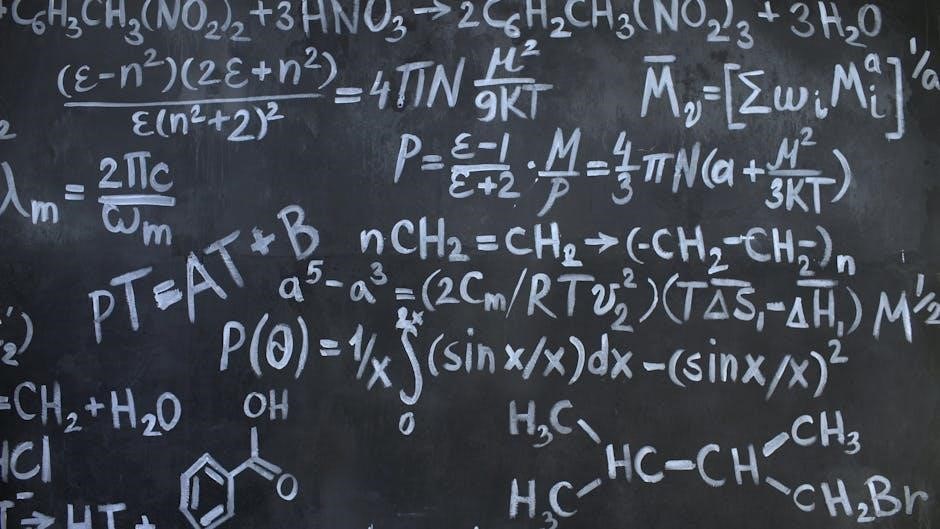This guide by Ivan Savov integrates math and physics, offering a jargon-free, concise approach for first-year university students. It emphasizes understanding connections between concepts, making complex topics accessible and engaging for learners at any level.
1.1 Why Math and Physics Matter
Mathematics and physics form the backbone of modern science and technology, providing essential tools for problem-solving and critical thinking. These disciplines not only explain the workings of the universe but also drive innovation in engineering, medicine, and computing. By mastering math and physics, learners gain the ability to analyze complex systems, model real-world phenomena, and develop creative solutions. The integration of these subjects fosters a deeper understanding of their interconnectedness, making them indispensable for addressing global challenges and advancing knowledge. This guide emphasizes their practical relevance, ensuring readers appreciate how math and physics shape everyday life and technological progress.
1.2 The Unique Approach of the Guide
The No Bullshit Guide to Math and Physics stands out for its integrated, jargon-free approach, combining calculus, mechanics, and foundational concepts into a cohesive framework. Ivan Savov’s concise lessons avoid unnecessary complexity, focusing on practical applications and intuitive explanations. The guide emphasizes understanding over memorization, highlighting the deep connections between math and physics. With engaging examples, practice problems, and clear diagrams, it caters to both beginners and advanced learners. The book’s humorous tone and real-world relevance make complex topics enjoyable and accessible. By breaking down subjects into digestible sections, it ensures a smooth learning curve, helping readers build a strong foundation without overwhelming them with theoretical jargon.

Core Concepts in Math and Physics
The guide covers essential math fundamentals and foundational physics principles, bridging gaps between abstract concepts and practical applications. It emphasizes understanding and real-world connections, making complex topics accessible and engaging for all learners.
2.1 Essential Math Fundamentals
The guide begins with fundamental math concepts, ensuring a solid foundation for understanding physics. Topics include pre-calculus, functions, vectors, and basic calculus principles. The approach is straightforward, avoiding unnecessary complexity, and focuses on practical applications. Learners gain clarity on essential math tools, such as differential calculus and integral calculus, which are crucial for problem-solving in physics. The guide’s unique style makes these concepts accessible, even for those without a strong math background, by emphasizing intuition and real-world relevance. This section sets the stage for integrating math with physics seamlessly, highlighting how mathematical concepts are indispensable for understanding physical phenomena. The clear explanations and focused lessons ensure learners grasp these fundamentals efficiently and effectively.
2.2 Foundational Physics Principles
This section introduces core physics concepts, starting with mechanics, electromagnetism, and thermodynamics. The guide emphasizes the interplay between physical phenomena and mathematical tools, providing intuitive explanations. Key principles like motion, forces, energy, and momentum are explored in depth, with a focus on their practical applications. The text avoids jargon, ensuring clarity for learners at all levels. By integrating mathematical concepts, the guide illustrates how physics relies on math to describe and analyze the natural world; This foundational understanding prepares learners to tackle advanced topics, such as quantum mechanics and relativity, later in the book. The clear, concise approach makes complex physics principles accessible and engaging, fostering a deeper appreciation for the subject.
Calculus and Its Connection to Mechanics
This chapter explores the deep integration of calculus and mechanics, showing how mathematical principles model physical phenomena, making complex concepts engaging and accessible for learners.
3.1 Understanding Motion and Forces
This section explains how calculus is used to describe motion and forces, with a focus on practical applications. It covers basic concepts like velocity and acceleration, showing how they are derived from position-time graphs. The chapter emphasizes the relationship between forces and motion through Newton’s laws, demonstrating how calculus provides the tools to analyze and predict physical phenomena. By integrating calculus with mechanics, the guide makes these concepts intuitive and accessible, avoiding unnecessary complexity. This approach helps learners see the direct relevance of mathematical principles to real-world problems in physics and engineering. The clear, jargon-free explanations ensure that even those new to the subject can grasp these fundamental ideas effortlessly.
3.2 Energy and Work in Calculus
This section explores the fundamental relationship between energy, work, and calculus. It explains how calculus provides the tools to define and analyze these concepts, which are central to understanding physical systems. The guide introduces the idea of work as the integral of force over distance and energy as a state function, emphasizing their mathematical foundations. By integrating calculus with physical principles, the text demonstrates how energy conservation laws emerge naturally from these definitions. Practical examples illustrate how calculus is used to solve real-world problems involving energy and work, making these abstract concepts accessible and applicable. This approach ensures a deep understanding of the interplay between mathematical theory and physical phenomena.
3.3 Differential Equations in Mechanics
Differential equations are essential for describing how physical systems change over time or space. This section explains how these equations model real-world phenomena, such as the motion of objects under forces or the vibration of springs. The guide connects calculus to mechanics by deriving equations of motion from basic principles like Newton’s laws. It highlights the importance of solving these equations to predict system behavior, whether it’s the trajectory of a projectile or the oscillations of a pendulum. Practical examples illustrate how differential equations are applied to solve everyday engineering and physics problems, emphasizing their role in understanding and analyzing dynamic systems.
Linear Algebra for Physics and Engineering
Linear algebra is foundational for physics and engineering, providing tools like vectors and matrices to solve real-world problems. This section explains their practical applications clearly.
4.1 Vectors and Their Applications
Vectors are fundamental in math and physics, representing quantities with magnitude and direction. They are visually represented as arrows, with their length indicating magnitude and direction shown by their orientation in space. Vectors are essential for describing physical phenomena like velocity, force, and displacement. In physics, vectors enable the combination of forces acting in different directions, allowing for precise calculations of resultant forces. They also form the basis of more advanced concepts like vector fields and tensor analysis. In engineering, vectors are used to solve problems in structural analysis and fluid dynamics. The No Bullshit Guide explains vectors in an intuitive, jargon-free manner, making their applications in physics and engineering clear and accessible to learners at all levels.
4.2 Matrices and Transformations
Matrices are powerful tools in math and physics, enabling operations like addition, multiplication, and inversion. They represent systems of equations and transformations, such as scaling and rotation. In physics, matrices describe transformations in space, crucial for understanding motion and forces. They simplify solving complex systems of equations and are fundamental in quantum mechanics and engineering. The No Bullshit Guide explains matrices intuitively, emphasizing their practical applications. By mastering matrices, learners gain a robust framework for tackling real-world problems in physics, computer graphics, and machine learning. This section ensures a solid understanding of matrix operations and their transformative role in modern science and engineering.
4.3 Practical Uses in Physics
Linear algebra is indispensable in physics, providing tools to describe and analyze physical systems. Vectors and matrices are essential for understanding forces, motion, and transformations in space. In quantum mechanics, matrices represent operators for observables like energy and momentum. The guide explains how these mathematical concepts solve real-world physics problems, such as modeling electromagnetic fields or particle dynamics. By mastering these techniques, students can tackle complex systems in mechanics, electromagnetism, and quantum theory. The book emphasizes the practicality of linear algebra, showing how it bridges abstract math and physical phenomena, making it a cornerstone for problem-solving in modern physics.

Electricity and Magnetism Basics
This section introduces the fundamental concepts of electricity and magnetism, including electric fields, charge, and magnetic induction, laying the groundwork for understanding their interconnected roles in physics.
5.1 Electric Fields and Charge
Electric fields and charge are foundational concepts in understanding electricity. Electric charge, a fundamental property of matter, exists in two forms: positive and negative. The electric field, described by vectors, represents the force exerted on a charged particle within a field. Coulomb’s law explains the force between charges, while electric field lines visualize the field’s direction and strength. Gauss’s law provides a mathematical framework for calculating electric fields around symmetric charge distributions. The guide explains these concepts with clarity, avoiding unnecessary complexity, ensuring readers grasp the essentials of electric charge and field interactions, which are crucial for advanced topics in electromagnetism.
5.2 Magnetic Fields and Induction
Magnetic fields are a fundamental concept in physics, describing the influence of magnetic forces on moving charges and currents. The magnetic field, represented by the Lorentz force law, acts perpendicular to the velocity of a charge, creating a force that depends on the charge’s motion relative to the field. Ampère’s law provides a mathematical tool to calculate magnetic fields around current-carrying wires or solenoids, especially in symmetric configurations. Magnetic induction, explored through Faraday’s law, explains how changing magnetic fields produce electric fields, a principle essential for generators and transformers. The guide simplifies these concepts, linking them to practical applications and reinforcing the interconnected nature of electromagnetism.
5.3 Maxwell’s Equations Explained
Maxwell’s Equations form the cornerstone of classical electromagnetism, elegantly unifying the previously separate theories of electricity and magnetism. The four equations—Gauss’s law for electricity, Gauss’s law for magnetism, Faraday’s law of induction, and Ampère’s law with Maxwell’s addition—describe how electric and magnetic fields propagate and interact. These equations reveal the symmetries and conservation laws inherent in electromagnetic phenomena, such as the absence of magnetic monopoles and the generation of electromagnetic waves. By integrating these principles, Maxwell’s Equations not only explain natural phenomena but also underpin technologies like radio communication, electrical power distribution, and medical imaging, showcasing their profound impact on modern science and engineering.

Modern Topics in Math and Physics
This section explores cutting-edge concepts like relativity and quantum mechanics, building on foundational principles to reveal the intricate nature of space, time, and matter at microscopic scales.
Relativity, introduced by Albert Einstein, challenges classical mechanics by describing how space and time are relative. The guide simplifies special and general relativity, showing how they unify spacetime and gravity. Concepts like time dilation and length contraction are explained intuitively, avoiding heavy math. The section highlights how relativity connects to earlier topics like motion and forces, providing a deeper understanding of the universe’s structure. By focusing on core ideas, readers gain a clear grasp of relativity’s significance without getting lost in complex equations.
6.2 Quantum Mechanics Basics
Quantum mechanics introduces the fascinating world of the tiny, where particles like electrons and photons behave in ways that defy classical logic. This section explains the foundational concepts, such as wave-particle duality and the probabilistic nature of reality. The guide simplifies complex ideas like Schrödinger’s equation and Heisenberg’s uncertainty principle, making them accessible to readers without a deep math background. By connecting quantum mechanics to earlier topics like calculus and linear algebra, the book shows how these tools are essential for understanding quantum systems. Practical examples, such as the behavior of atoms and the operation of lasers, illustrate the real-world impact of quantum principles. This section provides a clear, intuitive introduction to the quantum world, avoiding unnecessary jargon and focusing on core ideas.
Practical Applications of Math and Physics
Math and physics form the backbone of engineering, technology, and data science. They enable innovations like AI, robotics, and medical imaging, solving real-world problems and driving progress.
7.1 Engineering and Technology
Math and physics are the foundational tools for engineering and technology. Engineers use calculus to design mechanical systems, optimize energy consumption, and model real-world phenomena. Linear algebra is essential for understanding electrical circuits and structural analysis. Physics principles like forces, motion, and energy are applied in robotics, aerospace engineering, and materials science. These disciplines enable the development of innovative technologies, from smartphones to medical devices. By mastering math and physics, engineers can create efficient solutions to complex problems, driving technological advancements across industries. The integration of these subjects ensures that engineers can tackle challenges methodically and innovatively, leading to groundbreaking discoveries and practical applications in everyday life.
7.2 Data Science and Machine Learning
Math and physics are cornerstone disciplines for data science and machine learning. Linear algebra underpins neural networks and data transformations, while calculus enables optimization of machine learning models. Probability and statistics, rooted in mathematical foundations, are crucial for data analysis and model validation. Physics-based approaches, such as energy minimization, inspire algorithms like k-means clustering. These mathematical tools allow data scientists to extract insights, build predictive models, and solve complex problems. By leveraging these principles, professionals in machine learning develop robust systems for tasks like image recognition, natural language processing, and decision-making. The integration of math and physics fosters innovation in data-driven fields, making them indispensable for modern technological advancements.
7.3 Everyday Problem Solving
Math and physics provide powerful tools for tackling everyday challenges. Understanding fundamental principles, such as motion, forces, and energy, can help optimize tasks like driving efficiently or arranging furniture. Algebraic thinking aids in budgeting, scaling recipes, or planning schedules. The logical reasoning cultivated through these subjects enhances decision-making in scenarios like comparing prices, managing resources, or evaluating risks. By applying mathematical and physical concepts to real-world situations, individuals can solve problems more effectively, saving time and effort. These skills also foster a deeper appreciation for how the world works, making everyday problem-solving more intuitive and rewarding. The guide emphasizes practical applications, making these tools accessible for daily life.

Tips for Learning Math and Physics Effectively
Start with the basics, then apply concepts to real-world problems. Stay engaged by solving practical examples. This approach ensures clarity and makes complex topics accessible.
8.1 How to Study Smart, Not Hard
Focus on understanding core concepts rather than memorizing formulas. Use active recall by explaining ideas in your own words. Practice with purpose, tackling problems systematically. Prioritize quality over quantity, ensuring clarity before moving forward. Engage with material actively—ask questions, visualize processes, and connect new knowledge to prior learning. Eliminate distractions during study sessions to maintain focus. Regularly review and reflect on what you’ve learned to reinforce retention. Break complex topics into manageable chunks and integrate real-world applications. By studying efficiently and mindfully, you can master math and physics without unnecessary effort.
8.2 The Importance of Practice
Regular practice is essential for mastering math and physics; It strengthens problem-solving skills and builds intuition. Start with basic exercises to solidify fundamentals, then progress to more complex problems. Apply concepts to real-world scenarios to enhance understanding. Practice actively—don’t just read or watch; engage with the material. Use worked examples as guides, then attempt problems on your own. Review mistakes to identify gaps in knowledge. Consistency is key; short, focused sessions are more effective than marathon study periods. Over time, practice reduces reliance on memorization, fostering a deeper grasp of principles. This approach ensures long-term retention and prepares you for advanced topics seamlessly.
8.3 Using the Right Resources
Choosing the right resources is crucial for effective learning. The No Bullshit Guide to Math and Physics offers a unique, integrated approach that eliminates unnecessary complexity. Its concise, jargon-free lessons make it an ideal resource for self-study. Supplement this guide with online tutorials and video lectures for visual learners. Practice problems and past exams are essential for reinforcing concepts. Utilize interactive tools like graphing calculators and simulation software to visualize complex ideas. Join study groups or forums to discuss challenges and share insights. Regularly review notes and textbook chapters to ensure comprehension. By combining these resources, you create a well-rounded learning environment that supports your journey in mastering math and physics.
The No Bullshit Guide to Math and Physics provides a comprehensive and accessible path to mastering essential concepts. By integrating math and physics, it highlights their natural connections, making learning engaging and effective. Ivan Savov’s approach emphasizes understanding over memorization, ensuring readers grasp the fundamentals deeply. The guide’s concise, jargon-free style caters to both beginners and advanced learners, offering a refreshing alternative to traditional textbooks. With its focus on practical applications and real-world relevance, this guide empowers students to tackle complex problems with confidence. Whether for academic success or personal enrichment, the No Bullshit Guide serves as an invaluable resource, inspiring a lifelong appreciation for math and physics.
